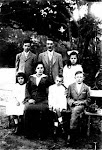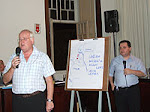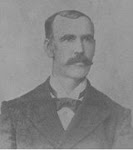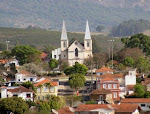domingo, 22 de outubro de 2017
Short biography of Maerten Lem
sábado, 19 de dezembro de 2015
quinta-feira, 3 de dezembro de 2015
Maerten Lem and Adrienne Van Nieuwenhove, our first in Belgium.
The Lem family originates from Bruges in Flanders. One of the oldest members of the family, Maertin Lem, his fathers name was also Maertin, settled temporarily in Lisbon in the middle of the fifteenth century1. He was merchant in Lisbon and acted as a banker for king Alfonso V, but Maertin stayed all the time citizen (poorter) of Bruges. In 1463 Maertin was ennobled in Portugal with his own coat of arms. 1450-1485 In 1450 Rombout de Wachtere ordered Maertin Lem to go to Portugal in order to solve a problem between Rombout and two of his agents about the sale of jewels. Therefore Maertin needed letters of recommendation for the Portuguese court. After getting these letters Maertin solved the problems for the time being2. Because Maertin got these orders we may conclude that he was not unknown in Portugal, had been there before and had knowledge about trading. After his introduction at the court his career gained momentum. In 1452 Maertin is mentioned as agent and companion of Zegher Parmentier3 and in 1456 he signed a contract with king Alfonso V and got the monopoly for ten years for the export of cork4. In 1463 Maertin loaned money to the king and supported the siege of Tanger. Furthermore Maertin got permission that same year for himself and his companions to bear weapons5. In 1464 the king legitimated, on demand of Maertin, the seven children (among them another Maertin and an Antonio Leme) of Maertin and his girlfriend Leonor Rodrigues6. In the same year Maertin was ennobled (esqudeiro) and got his own coat of arms. (Tree black ‘merletten’ on a silver shield)7. In 1466, at the end of the contract with king Alfonso V, Maertin went back to Bruges, where Rombout and Maertin started a trial about the jewel case from 14508. This trial lasted till august 1467. In September 1467 Maertin9 became ‘Burgomaster of the corpse’. In the same year he married with Adrienne van Nieuwenhove. The couple got nine children. During the next years Maertin became several times mayor of ‘the corpse’ and of the aldermen. In 1479 he became superintendent of Maximiliaan from Austria10. In 1482 Maertin became, although he was a citizen of Bruges, bailiff of this city. Maertin and Adrienne lived in house Ryckenbuerch were they invited Maximiliaan several times for a dinner party. Maertins position was often contested; the people called him ‘count without a country’ or ‘the little count of Flanders’. During the troubles of 1483 Maertin went to live in Louvain where he died on 27 March 148511. Maertin was, several years later, buried in the chapel of Peter and Paul (also called the Lem chapel) in the church of St. Donaat in Bruges. 1 The name Lem is mentioned before in Bruges and Sint-Winoksbergen, but a connection with this Maertin wasn’t found yet. 2 Civiele sententiën Brugge register 1465-1469; folio 24v; 55v; 132; 66;74; 83; 85v; 87v; 88; 89; 91v-93’132. 3 Civiele sententiën Brugge register 1447-1453; folio 259v. 4 Arquivo Nacional da Torre do Tombo in Lisbon Chancellary of D. Alfonso V, book 13, folio 134. 5 Arquivo Nacional da Torre do Tombo in Lisbon Chancellary of D. Alfonso V, book 9, folio 5. 6 Arquivo Nacional da Torre do Tombo in Lisbon Chancellary of D. Alfonso V, book 8, folio 66 & 67. 7 Livro do Armeire mor 1505. 8 Civiele sententiën Brugge register 1465-1469 several folio numbers see note 3. 9 According to some later authors Maertin the mayor should have been the son of Maertin the merchant and Joanna de Barrosos. This marriage and son Maertin is not documented in primary sources. 10 Dr. Jelle Haemers; for the common good. 11 Nicolaes Despars, van den lande ende graefscepe van Vlaenderen, 1840, IV, page 245. In 1471 Maertin send a boat with soldiers under command of his son Antonio to Portugal in order to participate in the siege of Arzila. For his brave behaviour Antonio was ennobled and he got his own coat of arms for him and his descendants (five black ‘merletten’ on a golden shield). Antonio served several years the Portuguese court before he became merchant and ship owner in Funchal. In Portugal, Maertin Lem was called Martime o’Velho (senior). His son with Leonor Rodrigues was called Martim o’Moco (junior). This Martim o’Moco continued the trade between Portugal and Bruges but died in the same year as his father, 1485. After Maertin (o’Moco)’s death Antonio took over the family business in Funchal. Antonio became the ancestor of the Brazilian Leme family. Portuguese coat of arms (Arquivo Nacional Torrdo Tombo Lisbon) Coat of arms on painting12 Maertin Lem in museum de Potterie. Wil Lem Maastricht, March 14, 2015. Stg. The Lem Family Association Médoclaan 218 6213 EG Maastricht lemspan@gmail.com 12 This is a painting from the seventeenth century made after a painting in the collection of Rapaert de Grass. On both paintings the quarters of the coat of arms are exchanged, see the foundation logo.
quarta-feira, 26 de janeiro de 2011
The book about the family history
domingo, 28 de março de 2010
Leme in Madeira - Pt.

Bom dia primos! On Madeira I got this copy of marriages and think you may find it interesting enough. Shortly I will be sending some useful details for including in the Blog.
Regards.
Ruud
Conheça mais dados sobre a família no trabalho do primo Clovis Lemes (clique)
quinta-feira, 18 de março de 2010
Those Lem-families in England.
quarta-feira, 25 de junho de 2008
The origins
That town was one important metropolis of Flanders, the country which occupied the west of Germany, northwestern France, Belgium and Holland. Because the commercial importance of that place, Brugges was a point where they were merchants worldwide. Thus, as Portugal is highlighted in maritime trade, the Portuguese there also marketed the products they brought their caravels, such as spices, timber and later, the sugar that would be produced on the island of Madeira, after Brazil. That was a point of trade and generation of wealth, and inevitably the Lem with their boats have become common visitors in Lisbon. With the Portuguese, our relatives have signed contracts, including a monopoly on the transport and marketing of “cortices”( product used in cap of wine bottles) from the portuguese lands. The first of these data Lem is still unclear, and will unlikely be clarified. Through several researchers have some information, but full of assumptions, based on calculations of time, estimate the lives and some records and citations on our most remote ancestors of the family. Pedro Taques of Ameida Leme, Luiz Gonzaga da Silva Leme, and others are devoted a lifetime to find those sources based on other studies such as Manoel Soeiro in their Anaes of Flandes. Later this matter back to the surface with Jose (Silva Lemes) Guimaraes, in research on its origins that with the help of Monsignor Jose Patrocinio Lefort, from Campanha, the first founded town in south of Minas Gerais State (Brazil), the mother of many others towns, Cambuquira, for exemple.
Today, many of the descendants of Lem, in Europe, America and elsewhere try to find out more details about the origin in remote times.
In Brazil, we are many descendants of the first Leme ( Portuguese form of the name Lem). In our country We have the Leme Blood from island of Madeira, where the first Lem arrived in XV Century.
Bruges (Brugge in Dutch; pop. 45,000, or 117,000 with the suburbs) is the capital of the province of Western Flanders and Belgium most touristic city, with 2 million annual visitors.This perfectly preserved (or actually restored) medieval town of little canals has been called the Venice of the North and certainly deserves this reputation.
History
Bruges was founded in the 9th century by a group of Vikings. The name 'Bruges' probably comes from the old-Norse word 'Bryggja', which means 'landing stage, or mooring place'. In the late 9th century, Baldwin the Iron Arm, first Count of Flanders, fortified the city, ironically against other raiding Vikings.
Bruges developed as a port, directly accesible from the sea until about 1050 AD. Then the natural waterways silted up, but Bruges remained connected to the sea via a the Zwin canal until the 15th century, although via outports like Damme and Sluis.
Bruges grew as one of the main textile manufacturing and trading centre in Europe, along with Ghent and Ypres.
In 1300, Flanders was annexed to France by King Philip IV the Fair. The king visited Bruges the next year, and his wife, Joanna of Navarre, was so impressed by the prosperity and opulent attires of the locals that she said "I thought I alone was queen, but I see that here I have 600 rivals".
See More informations:
http://www.eupedia.com/belgium/bruges.shtml








